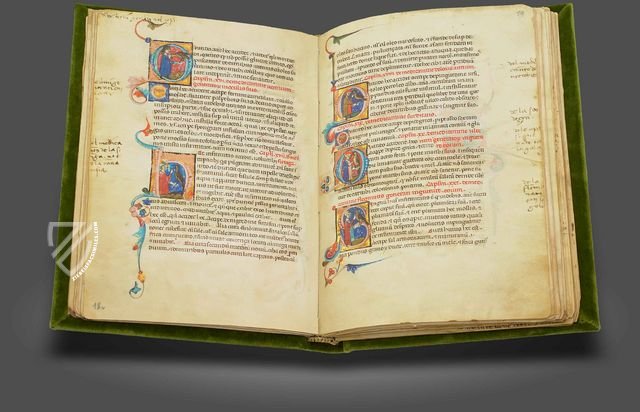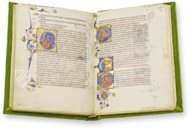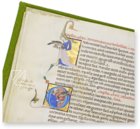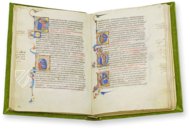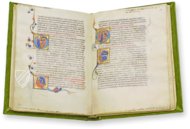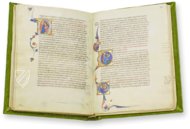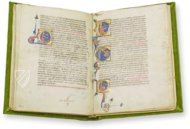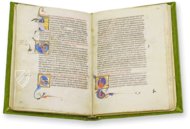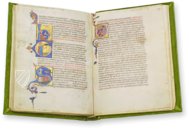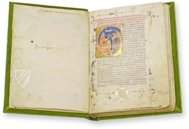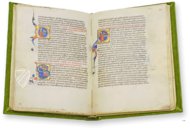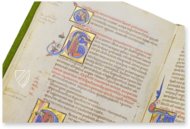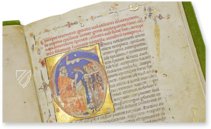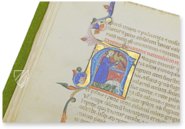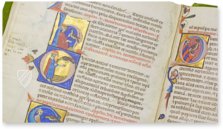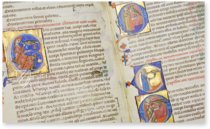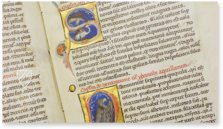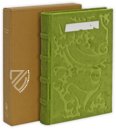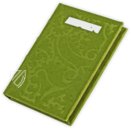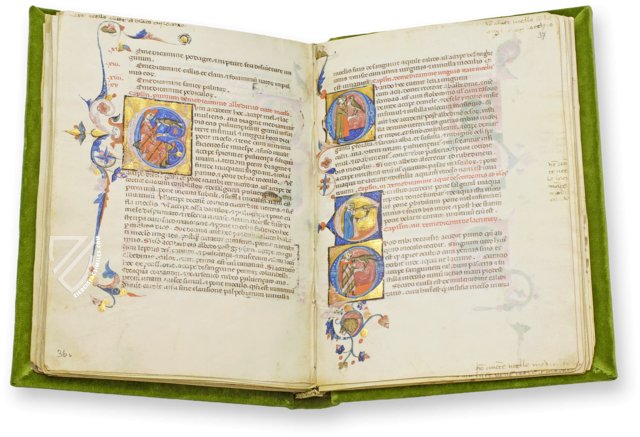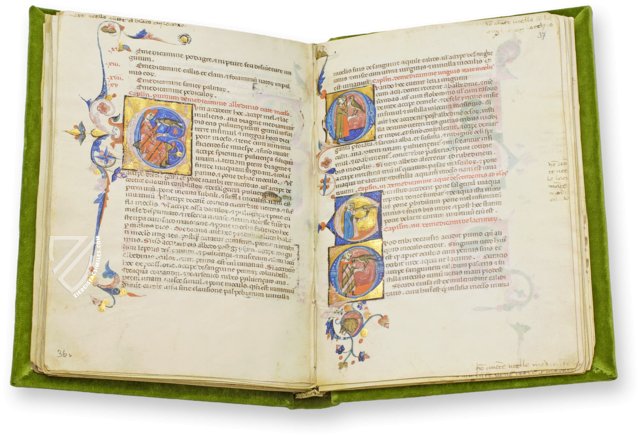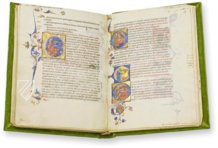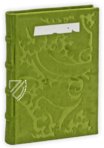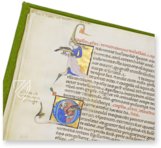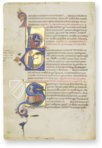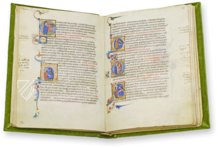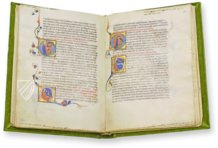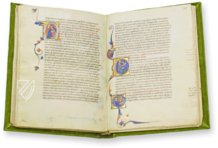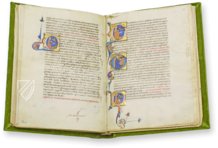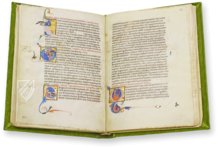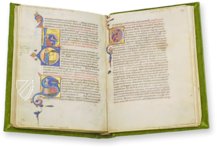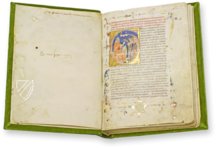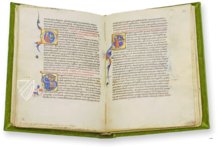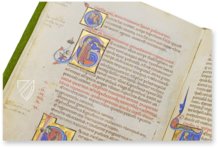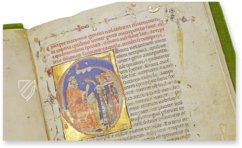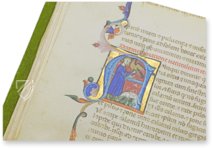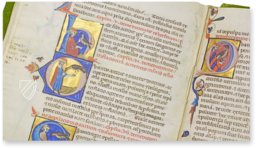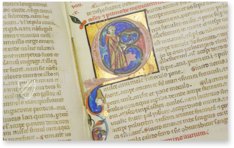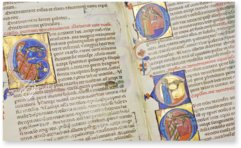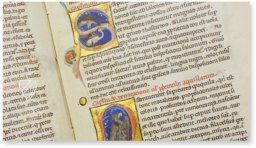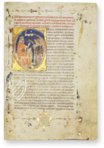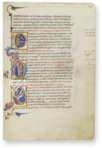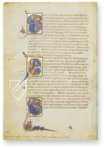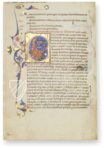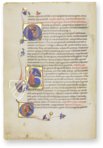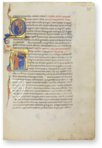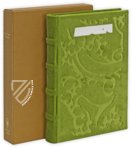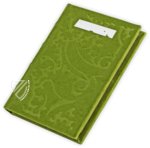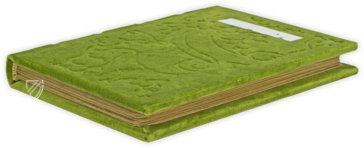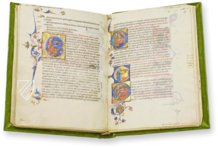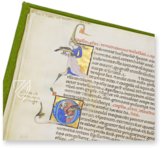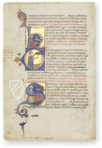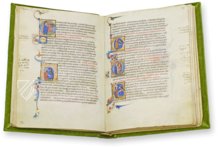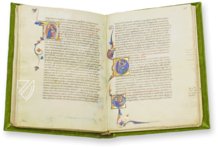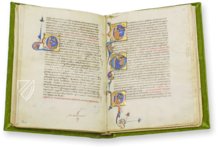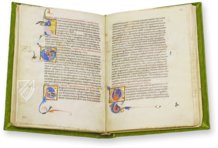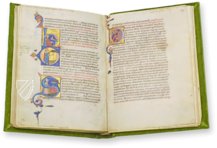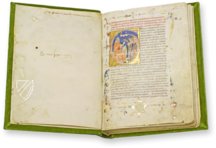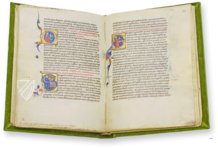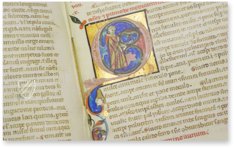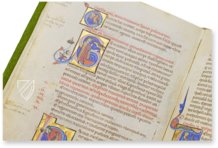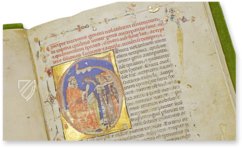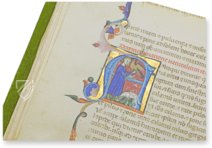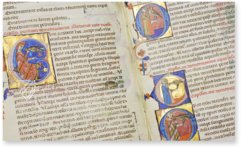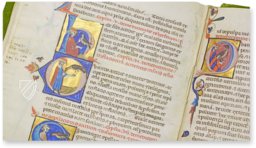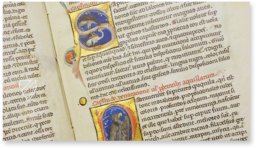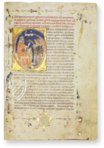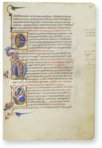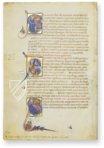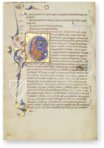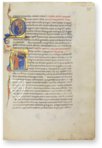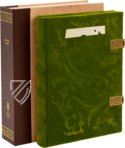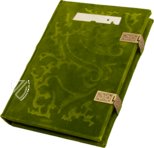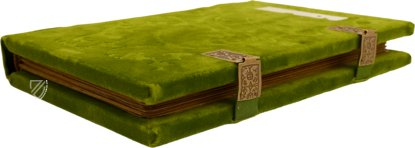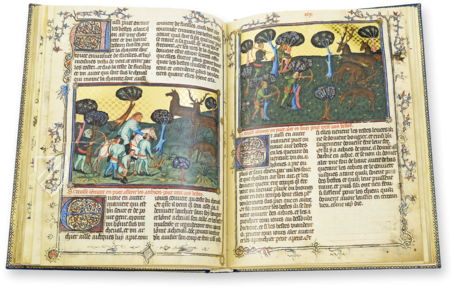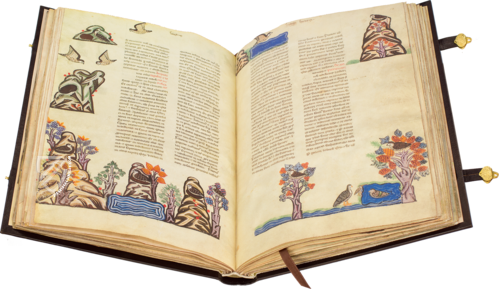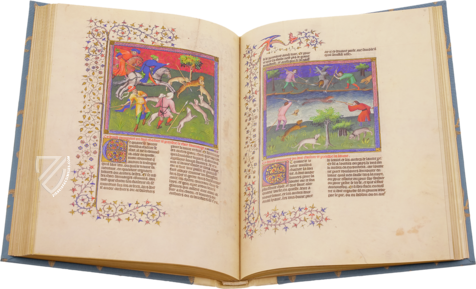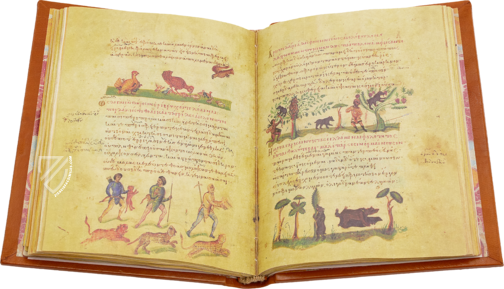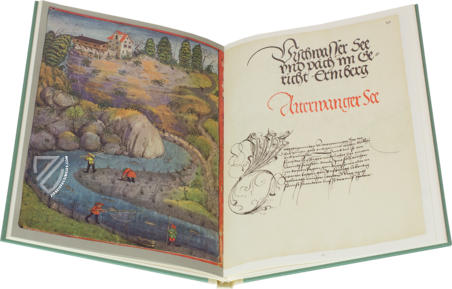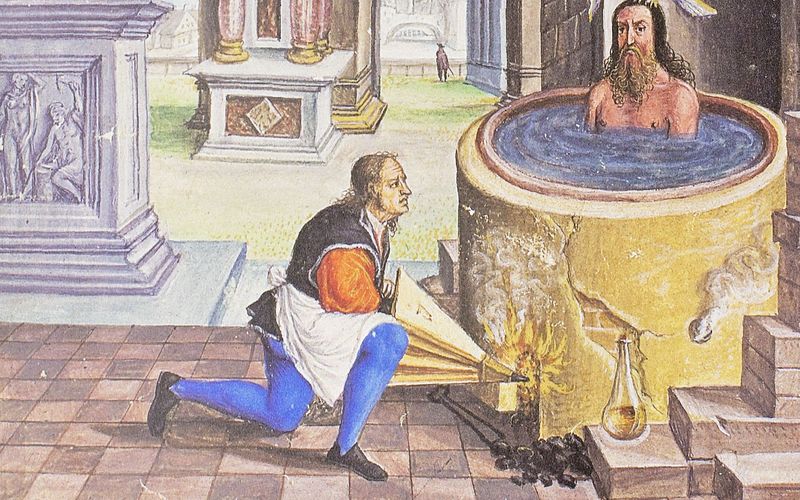Latin Moamin
(1,000€ - 3,000€)
Alongside his own famous falcon book, the so-called Latin Moamin is further proof of Emperor Frederick II’s fascination with the art of falconry. The emperor had the Arab treatise about hunting with falcons and dogs translated into Latin ca. 1240 and introduced his own ideas as well. A uniquely splendid edition of this manuscript created ca. 1275 is stored in Vienna, which is presented with lovely, thematic illustrations. It is a practical text divided into five books: the first three contain fundamental knowledge of falcons and falconry, the illnesses of birds, and their treatment while the 4th and 5th books are concerned with hunting dogs. 101 historiated initials illustrate the text with images of birds molting or hunting, always in cooperation with their handler, training and caring for sick falcons, and beautiful depictions of the dogs who worked in conjunction with them.
Latin Moamin - Liber Moamin falconarii de scientia venandi per aves et quadrupeds
A famous falconry text is known by the name Moamin, which was compiled from two works from the 8th and 9th centuries. Holy Roman Emperor Frederick II, who greatly loved falconry not only as a pastime but as a science, allowed this treatise on hunting to be translated into Latin by Theodore of Antioch beginning in 1240. It served as inspiration for his own famous book on falconry.
The Imperial Passion for Falconry
Emperor Frederick II (1194–1250) of the house of Hohenstaufen was King of Sicily and became Holy Roman Emperor in 1220. As a patron of art and culture, he was famous above all for the falcon book that he himself wrote. De arte venandi cum avibus became the most important textbook on falconry and ornithology of the Middle Ages. Originating in the 1240’s, it is heavily influenced by another treatise on falconry, which is closely associated with the name of Frederick II: the so-called Moamin.
Liber Moamin falconarii de scientia venandi per aves et quadrupeds
The Book on the Science of Hunting with Birds and Quadrupeds was an ancient Arabic treatise on hunting. Text segments from the falcon book of al-Gitrif and from four books of the treatise for Caliph al-Mutawakkil were compiled in the 9th century for an Abbasid caliph in Baghdad. The author of this manuscript, which has not survived completely intact, was Mohamed, son of Abdullah the Falconer. Theodore of Antioch was already active as a learned doctor and astrologer for the sultan in Baghdad when he translated the treatise for Frederick II. According to an anecdote, the emperor personally oversaw and corrected this translation.
A Unique Manuscript
The so-called Moamin is divided into five books: the first three contain fundamental knowledge of falcons and falconry, the illnesses of birds, and their treatment. The 4th and 5th books are concerned with hunting dogs. Of the 27 specimens existing today, only two are splendidly illustrated. The so-called Latin Moamin of Vienna’s Kunsthistorisches Museum originated in Italy ca. 1275. The splendid codex, made for a wealthy patron, is adorned with 101 historiated initials, each in a rectangular frame with a precious gold background. Ornamental, fantastically bright frames adorn the pages as well. The high-quality illustrations show birds molting or hunting and always in cooperation with the person, as well as the training of the animals and caring for sick falcons. The rear portion of the manuscript – concerning hunting dogs – was appended at the later date with gorgeous depictions of dogs. A wonderful special feature contained in the Latin Moamin is the notes in Italian by the miniaturist, who is believed to have illustrated the text so splendidly. An intimate glimpse into the provenance of the manuscript!
Codicology
- Alternative Titles
- Wiener Moamin
De Scientia Venandi per Aves
Vienna Moamyn - Size / Format
- 108 pages / 22.0 × 15.4 cm
- Origin
- Italy
- Date
- Around 1240
- Style
- Genre
- Language
- Script
- Gothic Textura
- Illustrations
- 101 historiated initials on golden ground
- Content
- Treatise on falconry
- Patron
- Emperor Frederick II (1194–1250)
- Artist / School
- Theodore of Antioch (translator)
Latin Moamin
Falcons and Dogs
Hunting with falcons required more than a bird and a big leather glove, it also required the cooperation of well-trained hunting dogs. As such, there is a section of this manuscript dedicated specifically to man’s best friend. These two historiated “S” initials show falconers tending their birds, one is feeding while the other is enjoying some caresses on its chest. White hunting dogs can be seen next to both golden initials, meandering nearby in a naturalistic manner.
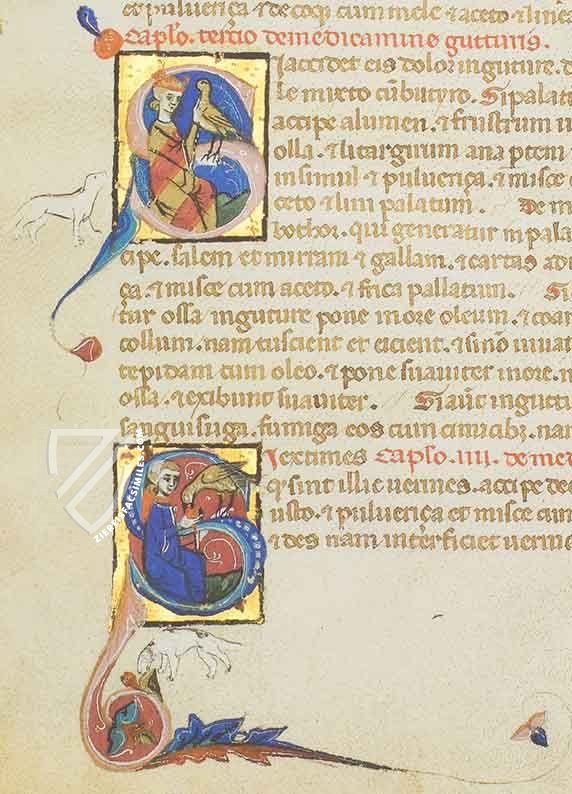
Latin Moamin
Eye Disease
The third book of this text consists of 15 chapters concerning the treatment of external diseases in falcons. This is the first page of the chapter, which is not surprising considering the importance of a falcon’s eyes for hunting. A unique feature of the page is the marginalia – tendrils of red, blue, and gold that spring from a head appearing on the left side of the initial.
This historiated “C” initial spans ten lines and is framed by gold leaf, it contains a falconer dressed in lavish red garments – a patterned robe and hat – who is meticulously inspecting his falcon’s eyes. They sit in front of night-blue background. The falcon’s illness is described as albedo in oculis or “whiteness in the eyes”, likely pointing to corneal leukoma.
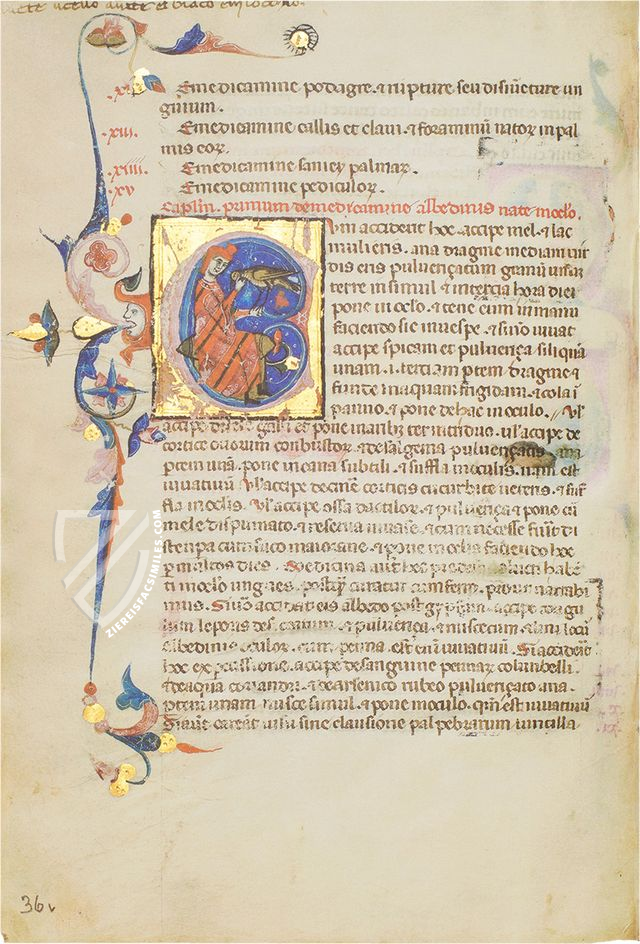
#1 Der Wiener Moamin (Normal Edition)
Language: German
(1,000€ - 3,000€)
#2 Der Wiener Moamin (Real Gold Edition)
Language: German
(3,000€ - 7,000€)
- Treatises / Secular Books
- Apocalypses / Beatus
- Astronomy / Astrology
- Bestiaries
- Bibles / Gospels
- Chronicles / History / Law
- Geography / Maps
- Saints' Lives
- Islam / Oriental
- Judaism / Hebrew
- Single Leaf Collections
- Leonardo da Vinci
- Literature / Poetry
- Liturgical Manuscripts
- Medicine / Botany / Alchemy
- Music
- Mythology / Prophecies
- Psalters
- Other Religious Books
- Games / Hunting
- Private Devotion Books
- Other Genres
- Afghanistan
- Armenia
- Austria
- Belgium
- Belize
- Bosnia and Herzegovina
- China
- Colombia
- Costa Rica
- Croatia
- Cyprus
- Czech Republic
- Denmark
- Egypt
- El Salvador
- Ethiopia
- France
- Germany
- Greece
- Guatemala
- Honduras
- Hungary
- India
- Iran
- Iraq
- Israel
- Italy
- Japan
- Jordan
- Kazakhstan
- Kyrgyzstan
- Lebanon
- Liechtenstein
- Luxembourg
- Mexico
- Morocco
- Netherlands
- Palestine
- Panama
- Peru
- Poland
- Portugal
- Romania
- Russia
- Serbia
- Spain
- Sri Lanka
- Sweden
- Switzerland
- Syria
- Tajikistan
- Turkey
- Turkmenistan
- Ukraine
- United Kingdom
- United States
- Uzbekistan
- Vatican City
- A. Oosthoek, van Holkema & Warendorf
- Aboca Museum
- Ajuntament de Valencia
- Akademie Verlag
- Akademische Druck- u. Verlagsanstalt (ADEVA)
- Aldo Ausilio Editore - Bottega d’Erasmo
- Alecto Historical Editions
- Alkuin Verlag
- Almqvist & Wiksell
- Amilcare Pizzi
- Andreas & Andreas Verlagsbuchhandlung
- Archa 90
- Archiv Verlag
- Archivi Edizioni
- Arnold Verlag
- ARS
- Ars Magna
- ArtCodex
- AyN Ediciones
- Azimuth Editions
- Badenia Verlag
- Bärenreiter-Verlag
- Belser Verlag
- Belser Verlag / WK Wertkontor
- Benziger Verlag
- Bernardinum Wydawnictwo
- BiblioGemma
- Biblioteca Apostolica Vaticana (Vaticanstadt, Vaticanstadt)
- Bibliotheca Palatina Faksimile Verlag
- Bibliotheca Rara
- Boydell & Brewer
- Bramante Edizioni
- Bredius Genootschap
- Brepols Publishers
- British Library
- C. Weckesser
- Caixa Catalunya
- Canesi
- CAPSA, Ars Scriptoria
- Caratzas Brothers, Publishers
- Carus Verlag
- Casamassima Libri
- Centrum Cartographie Verlag GmbH
- Chavane Verlag
- Christian Brandstätter Verlag
- Circulo Cientifico
- Club Bibliófilo Versol
- Club du Livre
- CM Editores
- Collegium Graphicum
- Collezione Apocrifa Da Vinci
- Comissão Nacional para as Comemorações dos Descobrimentos Portugueses
- Coron Verlag
- Corvina
- CTHS
- D. S. Brewer
- Damon
- De Agostini/UTET
- De Nederlandsche Boekhandel
- De Schutter
- Deuschle & Stemmle
- Deutscher Verlag für Kunstwissenschaft
- DIAMM
- Droz
- E. Schreiber Graphische Kunstanstalten
- Ediciones Boreal
- Ediciones Grial
- Ediclube
- Edições Inapa
- Edilan
- Editalia
- Edition Deuschle
- Edition Georg Popp
- Edition Leipzig
- Edition Libri Illustri
- Editiones Reales Sitios S. L.
- Éditions de l'Oiseau Lyre
- Editions Medicina Rara
- Editorial Casariego
- Editorial Mintzoa
- Editrice Antenore
- Editrice Velar
- Edizioni Edison
- Egeria, S.L.
- Eikon Editores
- Electa
- Emery Walker Limited
- Enciclopèdia Catalana
- Eos-Verlag
- Ephesus Publishing
- Ernst Battenberg
- Eugrammia Press
- Extraordinary Editions
- Fackelverlag
- Facsimila Art & Edition
- Facsimile Editions Ltd.
- Facsimilia Art & Edition Ebert KG
- Faksimile Verlag
- Feuermann Verlag
- Folger Shakespeare Library
- Franco Cosimo Panini Editore
- Friedrich Wittig Verlag
- Fundación Hullera Vasco-Leonesa
- G. Braziller
- Gabriele Mazzotta Editore
- Gebr. Mann Verlag
- Gesellschaft für graphische Industrie
- Getty Research Institute
- Giovanni Domenico de Rossi
- Giunti Editore
- Graffiti
- Grafica European Center of Fine Arts
- Guido Pressler
- Guillermo Blazquez
- Gustav Kiepenheuer
- H. N. Abrams
- Harrassowitz
- Harvard University Press
- Helikon
- Hendrickson Publishers
- Henning Oppermann
- Herder Verlag
- Hes & De Graaf Publishers
- Hoepli
- Holbein-Verlag
- Houghton Library
- Hugo Schmidt Verlag
- Idion Verlag
- Il Bulino, edizioni d'arte
- ILte
- Imago
- Insel Verlag
- Insel-Verlag Anton Kippenberger
- Instituto de Estudios Altoaragoneses
- Instituto Nacional de Antropología e Historia
- Introligatornia Budnik Jerzy
- Istituto dell'Enciclopedia Italiana - Treccani
- Istituto Ellenico di Studi Bizantini e Postbizantini
- Istituto Geografico De Agostini
- Istituto Poligrafico e Zecca dello Stato
- Italarte Art Establishments
- Jan Thorbecke Verlag
- Johnson Reprint Corporation
- Josef Stocker
- Josef Stocker-Schmid
- Jugoslavija
- Karl W. Hiersemann
- Kasper Straube
- Kaydeda Ediciones
- Kindler Verlag / Coron Verlag
- Kodansha International Ltd.
- Konrad Kölbl Verlag
- Kurt Wolff Verlag
- La Liberia dello Stato
- La Linea Editrice
- La Meta Editore
- Lambert Schneider
- Landeskreditbank Baden-Württemberg
- Leo S. Olschki
- Les Incunables
- Liber Artis
- Library of Congress
- Libreria Musicale Italiana
- Lichtdruck
- Lito Immagine Editore
- Lumen Artis
- Lund Humphries
- M. Moleiro Editor
- Maison des Sciences de l'homme et de la société de Poitiers
- Manuscriptum
- Martinus Nijhoff
- Maruzen-Yushodo Co. Ltd.
- MASA
- Massada Publishers
- McGraw-Hill
- Metropolitan Museum of Art
- Militos
- Millennium Liber
- Müller & Schindler
- Nahar - Stavit
- Nahar and Steimatzky
- National Library of Wales
- Neri Pozza
- Nova Charta
- Oceanum Verlag
- Odeon
- Orbis Mediaevalis
- Orbis Pictus
- Österreichische Staatsdruckerei
- Oxford University Press
- Pageant Books
- Parzellers Buchverlag
- Patrimonio Ediciones
- Pattloch Verlag
- PIAF
- Pieper Verlag
- Plon-Nourrit et cie
- Poligrafiche Bolis
- Presses Universitaires de Strasbourg
- Prestel Verlag
- Princeton University Press
- Prisma Verlag
- Priuli & Verlucca, editori
- Pro Sport Verlag
- Propyläen Verlag
- Pytheas Books
- Quaternio Verlag Luzern
- Reales Sitios
- Recht-Verlag
- Reichert Verlag
- Reichsdruckerei
- Reprint Verlag
- Riehn & Reusch
- Roberto Vattori Editore
- Rosenkilde and Bagger
- Roxburghe Club
- Salerno Editrice
- Saltellus Press
- Sandoz
- Sarajevo Svjetlost
- Schöck ArtPrint Kft.
- Schulsinger Brothers
- Scolar Press
- Scrinium
- Scripta Maneant
- Scriptorium
- Shazar
- Siloé, arte y bibliofilia
- SISMEL - Edizioni del Galluzzo
- Sociedad Mexicana de Antropología
- Société des Bibliophiles & Iconophiles de Belgique
- Soncin Publishing
- Sorli Ediciones
- Stainer and Bell
- Studer
- Styria Verlag
- Sumptibus Pragopress
- Szegedi Tudomànyegyetem
- Taberna Libraria
- Tarshish Books
- Taschen
- Tempus Libri
- Testimonio Compañía Editorial
- Thames and Hudson
- The Clear Vue Publishing Partnership Limited
- The Facsimile Codex
- The Folio Society
- The Marquess of Normanby
- The Richard III and Yorkist History Trust
- Tip.Le.Co
- TouchArt
- TREC Publishing House
- TRI Publishing Co.
- Trident Editore
- Tuliba Collection
- Typis Regiae Officinae Polygraphicae
- Union Verlag Berlin
- Universidad de Granada
- University of California Press
- University of Chicago Press
- Urs Graf
- Vallecchi
- Van Wijnen
- VCH, Acta Humaniora
- VDI Verlag
- VEB Deutscher Verlag für Musik
- Verlag Anton Pustet / Andreas Verlag
- Verlag Bibliophile Drucke Josef Stocker
- Verlag der Münchner Drucke
- Verlag für Regionalgeschichte
- Verlag Styria
- Vicent Garcia Editores
- W. Turnowski Ltd.
- W. Turnowsky
- Waanders Printers
- Wiener Mechitharisten-Congregation (Wien, Österreich)
- Wissenschaftliche Buchgesellschaft
- Wissenschaftliche Verlagsgesellschaft
- Wydawnictwo Dolnoslaskie
- Xuntanza Editorial
- Zakład Narodowy
- Zollikofer AG

